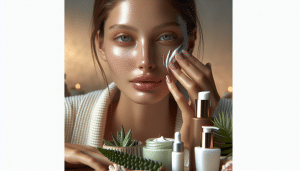Facial Serums Decoded for Radiant Skin
Natalie Brooks September 26, 2025
Find out how facial serums can transform your skin’s radiance and improve hydration, texture, and overall glow. This guide delves into why serums have become essential in modern beauty routines and explores popular ingredients, application tips, and what science says about their visible benefits.
The Rise of Facial Serums in Beauty Routines
Facial serums have rapidly shifted from niche skincare secrets to must-have essentials in everyday beauty routines. Thanks to their lightweight, concentrated formulas, these products deliver potent ingredients directly to the skin. Many users report noticeable improvements in hydration and overall radiance, which drives lasting popularity. Unlike heavier creams, serums don’t leave a greasy residue, making them appealing for both daytime and nighttime use. This suitability for various skin types adds real flexibility to any beauty regimen.
Many serums are formulated with active ingredients like hyaluronic acid, vitamin C, niacinamide, and peptides. These boost the serum’s impact on skin texture and radiance. The minimalist approach of serums—targeting specific skin concerns—attracts people seeking personalized routines. They synergistically complement other products, enhancing moisturizer or sunscreen efficacy. Integrating serums doesn’t require a dramatic overhaul of your current skincare practices but does provide immediate and long-term results when used consistently.
Recent trends in global skincare emphasize the importance of targeted solutions. Facial serums fit this model perfectly, catering to needs like hydration, anti-aging, brightening, or calming sensitivity. The lightweight texture allows deep penetration, which is often emphasized in dermatological studies. Their adaptability has encouraged a wave of products suitable for all ages and backgrounds. By embracing facial serums, people become more aware of specific ingredients, encouraging informed beauty choices every day.
Understanding Key Ingredients That Deliver Results
The true power of a facial serum lies in its key ingredients. Hyaluronic acid is renowned for drawing moisture into the skin, offering a plumper, more hydrated appearance. In contrast, vitamin C is celebrated for its brightening effects and ability to even out discoloration. Both have been scientifically reviewed for their effectiveness and safety, adding extra appeal for skin-minded individuals.
Niacinamide, or vitamin B3, is another sought-after compound. It helps calm inflammation, minimize pores, and strengthen the skin’s protective barrier. Meanwhile, peptides encourage collagen production—helping reduce signs of aging like fine lines and loss of firmness. Choosing serums that combine several of these ingredients may offer broader benefits. Informed selection ensures a more customized approach to your skincare goals, especially if you want multiple improvements at once.
It’s worth noting that sensitive or reactive skin types may respond differently to active ingredients, especially when highly concentrated. Dermatologists often recommend patch-testing and gradual introduction. Opt for fragrance-free or hypoallergenic options if sensitivity is a concern. The complexity of modern serums means there’s a solution for nearly every skin issue. Ingredient transparency is growing more common, empowering everyone to make safe, evidence-backed choices for skin wellness (Source: https://www.aad.org/public/everyday-care/skin-care-basics/care/10-ways-to-get-glowing-skin).
How to Apply Facial Serums for Maximum Radiance
Application technique can make a noticeable difference in how facial serums perform. Begin with a gentle cleanser to remove impurities and allow the skin to dry slightly. A few drops of serum applied with clean fingertips typically suffice—less is often more when it comes to serums. Massage the product evenly over the face and neck, pressing lightly to encourage absorption without tugging on delicate skin.
Serum order matters! Generally, apply serums after cleansing but before heavier products like moisturizers or sunscreens. This sequencing lets active ingredients penetrate deeper. Wait a minute or two between layers so each product has time to settle. Layering can seem like art, but evidence shows it really enhances efficacy. Serums can be used morning, evening, or both—just remember to adjust according to ingredient potency and sun sensitivity (such as retinol or potent vitamin C).
Consistency delivers results. Even high-quality serums need regular use for noticeable changes. Many users report visible radiance, improved skin texture, or hydration within several weeks. To lock in benefits, finish your routine with a broad-spectrum sunscreen during the day. Proper technique protects your investment and encourages lasting wellness and beauty improvements (Source: https://www.niams.nih.gov/health-topics/skin-care).
What Science Says About Efficacy and Safety
The effectiveness of facial serums receives regular attention in clinical dermatology. Many studies examine active ingredients like hyaluronic acid for moisture retention or antioxidants such as vitamin C for free-radical protection. Clinical trials often show that serum users report smoother, brighter complexions. Science tends to support these experiences overall, especially when serums are matched to skin type and concern.
It’s important to consider possible side effects or irritation, particularly with high concentrations of acids or retinoids. Dermatologists suggest monitoring for signs of redness, excessive dryness, or breakouts. If a new serum causes discomfort, stop use and consult a professional. Patch testing on a small area, such as behind the ear, is a prudent first step for sensitive skin (Source: https://www.ncbi.nlm.nih.gov/pmc/articles/PMC6017965/).
Transparency in labeling and third-party testing is a positive trend in the serum market. Look for brands disclosing comprehensive ingredients lists and clinical results where possible. Independent reviews and dermatologist endorsements help distinguish reliable options from the rest. When safety and effectiveness are confirmed, facial serums become a powerful addition to any beauty and wellness plan (Source: https://www.health.harvard.edu/blog/skincare-products-whats-most-effective-2020012218666).
Selecting the Right Serum for Your Skin’s Unique Needs
No single serum fits all. Each skin type—whether oily, dry, sensitive, or combination—benefits from tailored ingredient selection. People with oily skin may favor lightweight, non-comedogenic formulas like those rich in niacinamide. Dry or dehydrated skin often responds best to humectant serums that boost hydration such as formulas with hyaluronic acid or squalane.
Mature skin may seek out collagen-boosting ingredients like peptides or antioxidant blends to address fine lines and dullness. Those with uneven tone or visible discoloration often benefit from vitamin C or mild exfoliating acids. Some serums are formulated for day use (for radiance and protection), while others are meant for nighttime repair. Customizing your approach reduces irritation and enhances outcomes, resulting in healthier-looking and radiant skin.
Navigating the crowded market of facial serums can feel overwhelming. Start by identifying your primary skincare goals and any sensitivities. Patch-test new products, consult professional resources, and gradually incorporate serums into your regular routine. With mindful selection and persistence, remarkable improvements in skin feel and glow may emerge (Source: https://www.womenshealth.gov/a-z-topics/skincare).
Maintaining Results and Supporting Overall Wellness
Glowing skin depends on more than using facial serums alone. Supporting hydration by drinking adequate water and incorporating a balanced diet rich in antioxidants plays an essential part in visible radiance. Proper sleep and regular gentle exercise encourage natural skin vitality and resilience. When internal and external wellness practices align, the benefits add up—creating a long-lasting glow.
Don’t forget the importance of sun protection. Daily SPF is a vital step that enhances any serum’s results by shielding the skin from premature aging and damage. Even the highest-quality serums cannot fully counter sun exposure without a proper barrier. Combined, these strategies create a holistic approach to beauty and wellness that sustains healthy, glowing skin year-round (Source: https://www.cancer.org/healthy/be-safe-in-sun/skin-cancer-prevention-and-early-detection/skin-protection.html).
Tracking progress through photos, journaling, or simply mindful self-reflection helps build motivation. Celebrate small improvements and adapt your routine as needed. By combining evidence-backed facial serums with sound lifestyle habits, you support your skin’s natural beauty—making every glow truly well-deserved.
References
1. American Academy of Dermatology. (n.d.). 10 ways to get glowing skin. Retrieved from https://www.aad.org/public/everyday-care/skin-care-basics/care/10-ways-to-get-glowing-skin
2. National Institute of Arthritis and Musculoskeletal and Skin Diseases. (n.d.). Skin care tips. Retrieved from https://www.niams.nih.gov/health-topics/skin-care
3. Jafferany, M., Huynh, T. V., Silverman, M. A., Zaidi, Z. (2018). Overview of skin care products. Retrieved from https://www.ncbi.nlm.nih.gov/pmc/articles/PMC6017965/
4. Harvard Health Publishing. (n.d.). Skincare products: what’s most effective? Retrieved from https://www.health.harvard.edu/blog/skincare-products-whats-most-effective-2020012218666
5. Office on Women’s Health. (n.d.). Skincare. Retrieved from https://www.womenshealth.gov/a-z-topics/skincare
6. American Cancer Society. (n.d.). Skin protection. Retrieved from https://www.cancer.org/healthy/be-safe-in-sun/skin-cancer-prevention-and-early-detection/skin-protection.html








